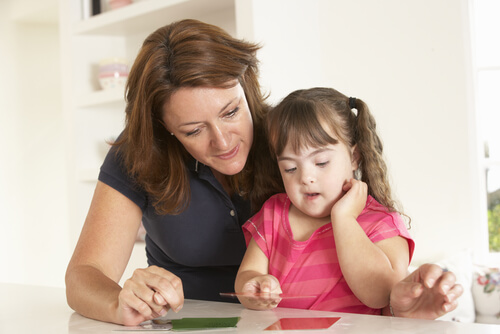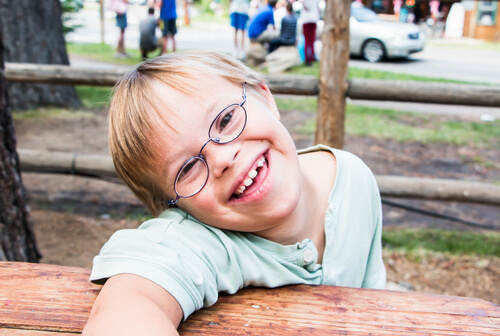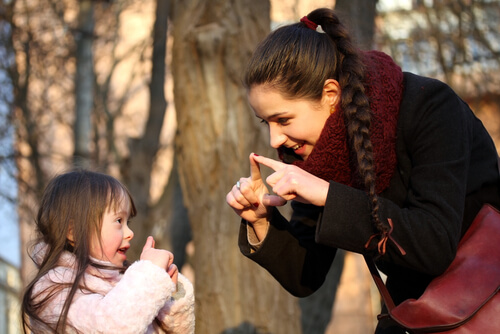Down Syndrome Education - Tips from a Teacher
Feb 11, 2022 First, some facts about Down syndrome – it is a condition some babies are born with where they have an extra chromosome.
In This Article
The Center for Disease Control (CDC) says that “chromosomes determine how a baby’s body forms during pregnancy and how the baby’s body functions as it grows in the womb and after birth. Babies with Down syndrome have an extra copy of one of these chromosomes, chromosome 21. A medical term for having an extra copy of a chromosome is ‘trisomy.’ Down syndrome is also referred to as ‘Trisomy 21.’ This extra copy changes how the baby’s body and brain develop, which can cause both mental and physical challenges for the baby.

Down syndrome is a lifelong condition. Services early in life will often help babies and children with Down syndrome to improve their physical and intellectual abilities. Most of these services focus on helping these children develop to their full potential. These services include speech, occupational, and physical therapy, and they are typically offered through early intervention programs in each state. Children with Down syndrome may also need extra help or attention in school, although many children are included in regular classes.”
This blog is an interview with Megan Casilla-Mwaura, who has firsthand experience in teaching kids with Down syndrome. She’s a middle school teacher in the United States who has a cousin whose child has Down syndrome. She also writes for various digital and mobile app websites. Megan was enlisted to help in teaching their child how to talk.
But first, there’s a resource that is helping people with Down syndrome speak better and sooner.
Down Syndrome Speech Therapy App
Speech Blubs is a language therapy app initially developed for children with autism, Down syndrome, and apraxia of speech! Once your child start speaking, Speech Blubs will help you as a complementary speech activity.
Start your free trial today and explore more than 1,500 fun and educational activities!
Boost Your Child’s Speech Development!
Improve language & communication skills with fun learning!

Interview with Megan
What was your learning process?
Children with Downs are generally very reliant on visual learning. Since their learning process is slower, it takes longer for them to process information. To speed that process up, I needed constant communication with the child.
Children with Downs have short-term memory for verbal communication. Usually, at two years old, toddlers can already speak words. But, for Downs kids it takes them around four years to start taking an interest in speaking.

My learning process starts with conditioning. Straight (no baby talk) speech with the child is crucial. My nephew can’t speak yet, but he still understands me very well.
I started going around the house, teaching him what items are called. As a matter of fact, his first actual word was ‘CALLED,’ referring to what a certain item’s name is.
He usually carries a small action figure of ‘Chopper’ from the world famous manga and anime franchise, “One Piece,” all the time. I used Chopper to introduce him to new words. We usually stay in one area of the house a week at a time. I initially wanted him to learn words from the kitchen so he could tell his mom what food he didn’t want to eat, but he took more interest in the bathroom because he loves taking baths so much.
What is your experience with speech therapy?
It’s easier when he is interested in speech therapy. Since children with Downs are very visual. he likes it when I exaggerate mouthing letters like ‘w,’ ‘l,’ the ‘th-sound,’ ‘r,’ and many more.
I have also used speech therapy apps, especially when we aren’t together. I’ve listed the apps here.
Describe your biggest challenge?
My nephew doesn’t easily learn words he is not interested in. He would frequently repeat words he is already familiar with and on some days, he would utterly refuse to learn anything new and just wanted to spend time with his mother.

Other than the typical behavioral issues, my biggest challenge is word retention, he forgets some terms when he learns new words.
Which methods worked for you?
‘Repetition’ and ‘Show and Tell.’ These two things have always worked for me when teaching kids with Down, or other types of autism.
Repetition while showing the items personally or with the use of flashcards, pictures, and videos helped a lot. Showing my nephew different colors and types of the same thing also helped.
Do you have some advice for parents and kids?
It’s all about patience. Any parent teaching a child with Downs needs a lot of it. And don’t be so strict if they can’t follow along. Give your child time to process new terms, give your child time to understand what you’re saying as well. Children with Downs are highly functional – as long as you teach them well.
Here’s a guide posted on our website.
Which tools do you use to improve speech?
I also use word app tools or picture dictionaries. These help a lot. but what helps a lot more are video calls. I’ll show him around my house or when I’m at the beach, I’ll call him and show him what a fish looks like or what color the sand is.

What kind of tools and resources do you usually need?
Teaching him one-on-one, I can never run out of paper to use for origami or a pen to draw images with. Having a pack of flashcards and a digital camera is key. My camera is important, in that I take pictures of things I see around so that the next time I see him I can show it to him.
I also use apps and learning tools. I ask my cousin to download them on her phone, and have her engage her son for 30 minutes of learning at a time and nothing more.
